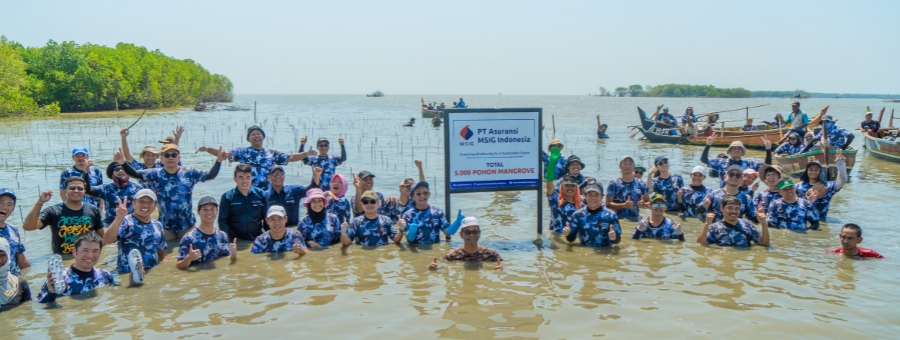MSIG Indonesia Planted 5,000 Mangroves at Bahagia Beach

MSIG Indonesia participated in mangrove planting efforts in Bahagia Beach, Muara Gembong, Bekasi. Citing information from the Sentral Rehabilitation Mangrove (SRM) Foundation, the existence of mangrove forests on the coast in the area continues to shrink and be damaged due to frequent abrasion. Currently, the mangrove forest in Muara Gembong Sub-district remains at around 600 hectares, down from the previous condition of 10,481.15 hectares, and nearly 350 families have lost their homes. To contribute to saving the area from further damage, MSIG Indonesia donated 5,000 mangrove trees to be planted. This activity is part of the company's journey to achieve net-zero carbon emissions by 2050.
MSIG Indonesia Team's Trip to Bahagia Beach
MSIG Indonesia Vice President Director Bernardus P. Wanandi said that mangrove forests store blue carbon, which can absorb greenhouse gas emissions, thus reducing the impact of climate change. In addition, mangrove forests are not only good for the environment but also for the community, especially those living around the mangrove forest ecosystem. By planting and preserving mangrove forests, it is expected to anticipate and reduce the impact of climate change, which is a major concern for the company.
Climate change exacerbates biodiversity loss by changing the physical and chemical conditions of ecosystems, such as temperature, rainfall, and sea level rise. The planting activity was supported by Yayasan SRM, a local non-profit organization that focuses on environmental conservation, particularly mangrove forest rehabilitation. The program aims to restore mangrove forest habitats that are vital for maintaining biodiversity, protecting coastlines, and mitigating climate change.
SRM Foundation Trustee, Imanuel Iman, said, "There has been massive damage in Muara Gembong. More than 940 hectares of land have been eroded by the sea. Land that was once land has now become sea. That is the reason why we chose to carry out rehabilitation efforts at this location. In addition, the planting that we do also has another function, not only to rehabilitate mangroves but also to help local communities that have lost their livelihoods. First, the seedlings planted came from the community. Secondly, from the mangrove maintenance that we provide every month. Then the surrounding community also gets income from planting activities with outside parties, such as boat facilities, as well as food for visitors who do the planting."
Iman also added that the SRM Foundation has the same vision as MSIG Indonesia regarding the climate change issue. "Mangrove forests can help reduce global warming because they have the ability to absorb four times more carbon than tropical forests. In tropical forests, when leaves and twigs fall, carbon is released. In mangrove forests, when twigs and leaves fall, they remain in the water. That's why mangrove forests have four times the carbon sequestration capacity of tropical forests."
Mangrove Planting Activity by MSIG Indonesia
This effort aligns with the company's mission to contribute to the development of a vibrant society and safeguard the future of the earth by providing security and peace of mind through the global insurance and financial services business. Preserving the earth and a good future for the next generation is a shared responsibility, from lifestyle changes that can be made by individuals to policies set by companies. For more information about MSIG Indonesia's commitment to biodiversity and sustainability, please visit https://www.msig.co.id/id/biodiversity.
